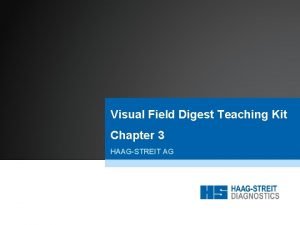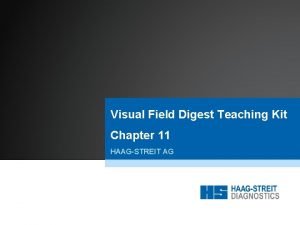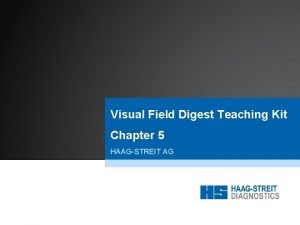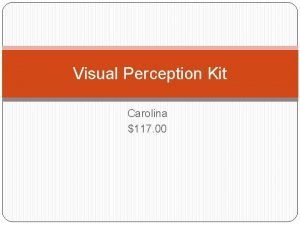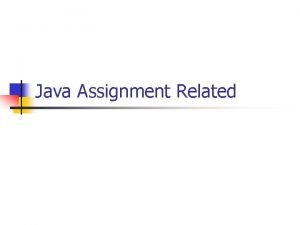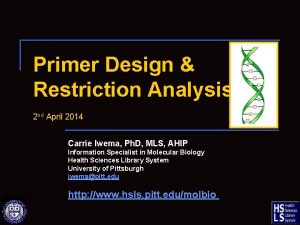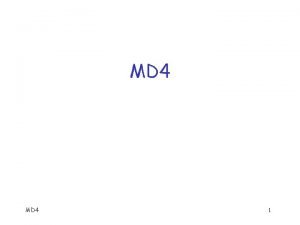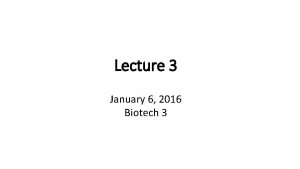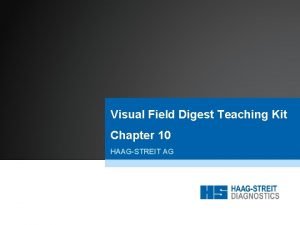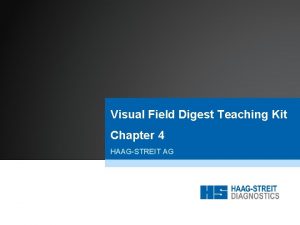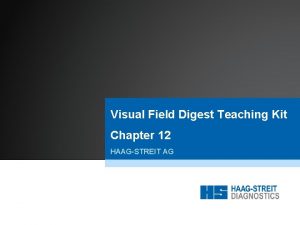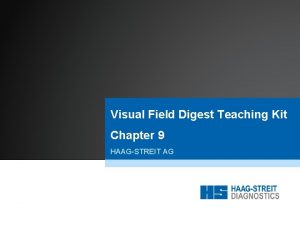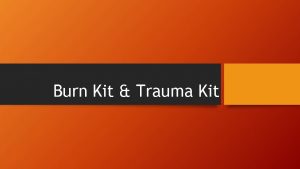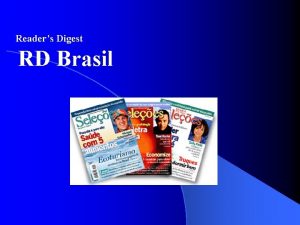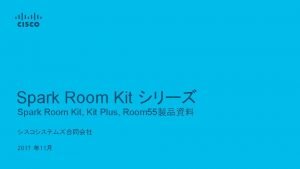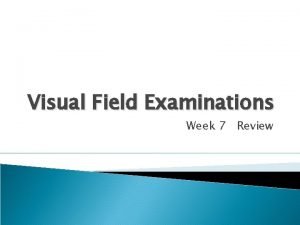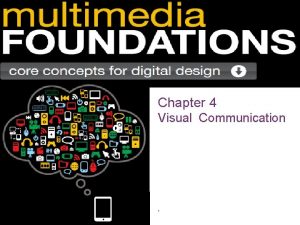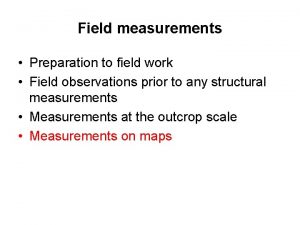Visual Field Digest Teaching Kit Chapter 8 HAAGSTREIT



































- Slides: 35

Visual Field Digest Teaching Kit Chapter 8 HAAG-STREIT AG

Teaching Kit Copyright § The Visual Field Digest Teaching Kit includes all figures and illustrations from the Visual Field Digest. They can be used for non-commercial presentations free of charge. § Haag-Streit AG allows the use of this figures for personal or academic use under the conditions that § (i) it is used without commercial purpose and § (ii) the content is reproduced exactly as the original by mentioning Haag-Streit AG, Switzerland as the owner of the copyright. § Non-academic, non-personal or commercial users might only use this figures in whole or in part after a written authorization by the copyright holder. § “Haag-Streit”, “ 900” and “Octopus” are either registered trademarks or trademarks of Haag-Streit Holding AG. § The following are either registered trademarks or trademarks of Carl Zeiss Meditec: “Guided Progression Analysis”, “GPA”, “Humphrey”, “HFA”, “SITA Fast”, “SITA Standard”, “Visual Field Index”, and “VFI”. § Copyright © 2018 HAAG-STREIT AG

Fig. 8 -1 -1: Visual field interpretation examples

Fig. 8 -1 -2: Visual field interpretation examples

Fig. 8 -1 -3: Visual field interpretation examples

Fig. 8 -2: Visual field interpretation workflow

Fig. 8 -3: Step 1 – Confirm patient and examination parameters

Fig. 8 -4: Overview of patient and examination parameters

Fig. 8 -5: Step 2 – Asses whether the visual field can be trusted

Fig. 8 -6: Untrustworthy visual field tests can show significant defects

Fig. 8 -7: Impact of false positive answers on visual field result

Fig. 8 -8: Impact of false negative answers on visual field result

Fig. 8 -9: Step 3 – Identify diffuse visual field loss

Fig. 8 -10: Defect Curve – Interpretation aid

Fig. 8 -11: Example of the clinical usefulness of the Defect Curve

Fig. 8 -12: Example of the clinical usefulness of the corrected representations

Fig. 8 -13: Step 4 – Distinguish between normal and abnormal visual fields

Fig. 8 -14: Probabilities and Corrected Probabilities – Interpretation aid

Fig. 8 -15: Clinical interpretation of Probabilities in borderline situations

Fig. 8 -16: Limitations of the Probabilities representation in advanced disease

Fig. 8 -17: Step 5 – Assess shape and depth of defect

Fig. 8 -18: Grayscale of Comparisons, Comparisons and Corrected Comparisons – Interpretation aid

Fig. 8 -19: Step 6 – Assess cluster defects in glaucoma

Fig. 8 -20: Cluster Analysis and Corrected Cluster Analysis –Interpretation aid

Fig. 8 -21: Illustration of the high sensitivity of Cluster Analysis to detect glaucoma

Fig. 8 -22: Step 7 – Where to look for structural defects

Fig. 8 -23: Polar Analysis – Interpretation aid

Fig. 8 -24: Illustration of the clinical usefulness of the Polar Analysis

Fig. 8 -25: Step 8 – Assess visual field severity

Fig. 8 -26: Step 8 – Illustration of the usefulness of MD

Fig. 8 -27: Illustration of the usefulness of s. LV

Table 8 -1: The etiology of diffuse and local visual field defects

Box 8 A: Grayscale representations are interpolated color maps

Box 8 B: Illustration of the clinical usefulness of Cluster Analysis

Box 8 C: Spatial relationship between visual fields and structural results
 Visual field digest
Visual field digest Visual field digest
Visual field digest Visual field digest
Visual field digest Visual field digest
Visual field digest Ip teaching kit
Ip teaching kit Carolina visual perception kit
Carolina visual perception kit System 44 decodable digest
System 44 decodable digest Message digest java
Message digest java Boat digest
Boat digest Forsyth county course digest
Forsyth county course digest Nebcutter
Nebcutter Message digest 4
Message digest 4 Caperatio
Caperatio Astd inf meta
Astd inf meta Job search digest
Job search digest Boat digest
Boat digest Webcutter neb
Webcutter neb Elders digest
Elders digest Traffic digest
Traffic digest Risks digest
Risks digest Fungi digest food
Fungi digest food Digestive system of frogs
Digestive system of frogs The 7 stages of marriage
The 7 stages of marriage Icra digest slide
Icra digest slide Database collection
Database collection Boat digest
Boat digest Microteaching cycle
Microteaching cycle Gauss law in magnetism
Gauss law in magnetism Individual differences factors
Individual differences factors Field dependent vs field independent
Field dependent vs field independent Electric field and magnetic field difference
Electric field and magnetic field difference Waveguide cutoff frequency
Waveguide cutoff frequency Data types and field properties
Data types and field properties Field dependent definition
Field dependent definition Magnetic field
Magnetic field Disadvantages of tape recorder in teaching and learning
Disadvantages of tape recorder in teaching and learning
